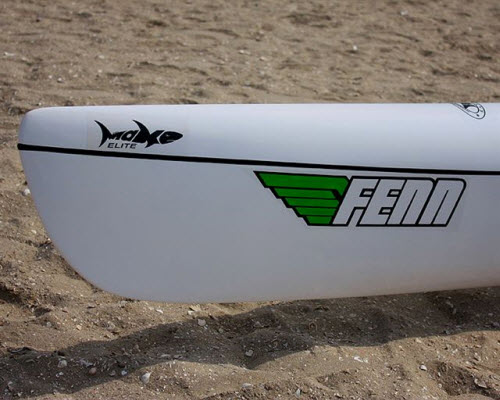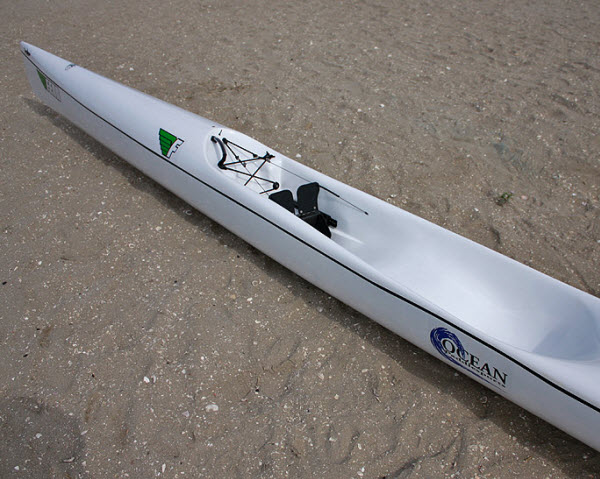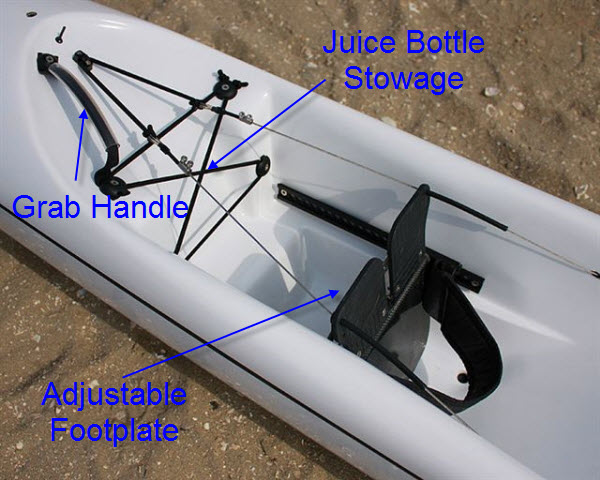First Looks: Fenn Mako Elite
The new Fenn Mako Elite has now been out for, what, 8 months? And, like others, I've been looking for a thorough review of the ski but haven't seen one. So, exercising fiduciary irresponsibility, I went ahead and purchased one before I had seen or paddled it.

First Impressions
I have since paddled it once - in one long race. Now, you might question the validity of a review of a ski that has been paddled once and, if so, then that would be normal. But, there is value in a first impression and the longer you own and paddle one particular ski, you tend to lose the sense of how it compares to your last ski. I won't commercialize this review by comparing the Elite across brands, but I will compare the Elite to the other Fenn racing skis - the Mako 6 (hereafter referred to as the "6") and the millennium.
I'm in the USA, and many of the ski paddlers here do not regularly paddle in ocean swell, shore breaks, or regular big downwind runs. Many of us buy skis based on how they perform on flat water, wind chop up to 4-6 ft / 2 m, and on rough and confused waters.
About the Author
A little about me: I paddled a carbon Mako 6 for the past 18 months with a 1 inch / 3 cm seat pad, and a carbon millennium (with the same height seat pad) for several years before that. These boats feel very stable to me in most all conditions. I'm now 5'10" / 178 cm tall (was 5'11" but compressed a lumbar disc!), 195 lbs / 88 kg, 43 years old. I really like the 6. It was a great improvement over the millennium in so many ways. I sold my 6 about a month ago and have been using a millennium for the past few weeks, so I've had the privilege of re-acquaintance with that old friend. I now hate having double foot-wells because if you learned to use good leg drive, you can't avoid tilting the ski left-right-left with your stroke. Plus, being more "locked" in the millennium seat bucket, with less ability to get leg drive and pelvic rotation, made my low back start to hurt again.
Carbon Mako Elite
Starting off, I sat in the carbon Elite for the first time on the grass the day before a 20 mile (30 km) race. What I noticed immediately is that the rear of the seat bucket has a better shape than the 6, as it tips the paddler forwards a bit. I found the 6 and millennium seats to encourage a bit of a slouch in my posture. The Elite's seat bucket width and shape is otherwise similar to the 6 at the bottom of the seat, but the top of the seat bucket is quite a bit narrower than the 6, maybe 2 cm narrower. It's probably pretty similar to the original millennium in seat width both at the bottom and top of the seat bucket.

As a reference, I'm a bit on the wide side as far as hip width is concerned, and I don't fit into most ICF K1's unless their seats are at the highest setting. I might have been comfortable in the Elite without a seat pad, but I had no problems with the seat bucket width with the seat pad in place. The foot-well area seemed similar to the 6 in size and shape - you can't get too excited about a single foot-well nowadays because they are all pretty nice.
For the race setup, I pimped the boat by adding a tight and solid foot pullbar - K1 style (made by duct taping a 1/2" diameter pvc pipe to the footstrap), taping in a closed cell foam seat pad (1 inch / 3 cm high), and taping in some padding on the inside edges of the seat rim (which I didn't really need).
Slightly less Twitchy
On the water, the Elite felt slightly less twitchy at a standstill than either the Mako 6 or the millennium. Leaning it over (still at rest) there wasn't any edge, just a smooth roll that didn't drop off a cliff like a K1 does. At speed (6-8 mph / 10-13 kph) on flatwater, the elite felt very solid and that relatively good primary stability was still there and even improved. I found the steering response on flat water to be much less than that of the 6 - which can throw you from the saddle if you do a "hardover" with the rudder, but the Elite's less responsive steering was not necessarily bad.
The long race that I did proved to be a good testing ground as it had all sorts of conditions ranging from glassy flat, glassy with small boat wake, i.e. the kind that is a bit unsettling as it leans you side-to-side. There were honest 2-3+ foot / 1m beam wind waves and boat wakes, the same size waves rear-quartering, in straight downwind, and accompanying a full frontal headwind. There was quite a bit of mixed up and confused water formed by refractory waves, tidal current waves, and boat wake.

For a larger version of this pic click here.
Narrow Ski
The Elite is a narrow ski, and it feels quite narrow - but that's not necessarily bad, either. As a narrow ski, with a rounder and narrower hull, it seemed to react to waves differently. On a millennium or a 6, beam waves or quartering waves seem to lift you up and tilt you left or right a bit. On the Elite, I seemed to get tilted a bit less which made me feel more stable - as long as I kept my center of gravity over the center of that narrower ski.
I didn't feel that the wind blew me around too much or that the volume in the bow was too much or too little. It just seemed about right - and similar to that of the 6, whereas the millennium seems to have the bow volume or shape not quite right.

Downwind Paddling
I thought that the Elite caught waves easily and surfed very well, but I don't think that the boat is inherently "faster" in a downwind, it just has a different feel. In the millennium and on the 6, when I'm just about to drop into a wave, that momentary position sometimes feels a bit precarious. You feel a bit perched up high, ready to fall one way or another. I didn't really encounter that in the Elite. It seemed to go nose down onto waves and into troughs just before I got that nervous "perched" feeling. My guess, "as a couch engineer", is that the Elite's narrower and longer bow starts dropping into the wave a hair earlier while its rudder stays planted for a longer time.
The Elite gathers speed on the wave normally and has that floating feeling almost as good as the 6 has, whereas I find the millennium to give a rather bumpy and wild ride. While the Elite steers sluggishly on the flats compared to the 6, it steered perfectly well on waves, and my rudder never felt like it broke free over several miles of steep 3 foot confused wave surfing. I also never felt as if I were about to broach or give a hard brace during the race, though using the 6 in those conditions might have been similar in all honesty.
I also didn't find myself over-steering or under-steering to get from one wave to another or while turning off of a wave. Transitioning from one wave to another, the Elite kept that solid feel and predictable steering. I have been told that some feel the Elite goes up and over smaller waves downwind better or keeps its speed downwind better than the 6 does, but that's something that's hard for me to either agree or disagree with at this point. With the hulls so similar in dimensions, I can't see how one could have a significantly easier time going through or over a wave in front of you. But, although I really like the 6 downwind, I could be convinced that I'd be marginally faster downwind on the Elite - not because it's a faster ski - but because it feels more stable / less twitchy, the steering seems more predictable, and because of this, I might miss fewer power strokes dropping into waves.
When going downwind and catching runs, to a certain extent, I don't think that it matters all that much how "fast" a particular ski is because we're all limited by the speed of the wave that we're on and by the wave immediately in front of and to the sides of us. The fastest paddler on a downwind might simply be the one who misses the fewest waves. And, if you are confident on your ski and are not missing any strokes by bracing, then that's about the best you can ask for. This past spring, I completed the Culebra Challenge on a Fenn Mako XT, and used that ski because of the unavailability of a "faster" boat. It was a downwind race with good surfing for most of the course. The point here is that and I don't think that I would have been significantly faster on a 6, had one been available.
Upwind and flat water paddling
Upwind and on the flats, it's hard to be certain about its speed with just one test. I also couldn't tell a difference in speed between the6 and the millennium on flat water. The Elite is at least as fast as the comparable skis like the 6 and those from other manufacturers.
And, seeing that many of the top South African paddlers who used to race 6's have changed over to the Elite kind of tells one that the Elite is not a slower boat.

Final Thoughts
So, as for my final thoughts: I really like the new Mako Elite - more than I like the Mako 6. Compared to the 6, the Elite is a narrower boat, and it feels narrower on the water. The Elite has a more comfortable seat than the 6 or millennium (which is subjective, obviously). It's less twitchy than the 6 (though I don't find the 6 very twitchy), and some of this may be due to a less responsive feel from the rudder. It tracks well and rolls side to side less with your stroke compared to the 6. On rough water, it kept some of that improved primary stability and gave me a bit more confidence while surfing and while transitioning from one wave to another as compared to the 6. The new Elite adds slightly more directional stability to the otherwise very successful 6, albeit in a narrower package. It's not a ski for everyone and not a beginner/intermediate's ski, and when I say that the Elite is more stable than the 6, it's a barely perceptible marginally more stable type of thing that you would only feel if you have pretty good stability to begin with.
If you are using a millennium, and want to stay with a Fenn for some reason, then you ought to move to the Elite if you can. It's another great hull from Keith Fenn, and the double to single footwell change is huge. The big question though comes from the current fleet of 6 paddlers: should they change over to the Elite? The answer is not a slam dunk as the differences are subtle and a changeover will likely not significantly improve one's times or placings in races. If you worship your 6, then stay with it. If you don't like the 6's seat, or want just a little bit more directional stability or a bit less rudder response then give the Elite a try.

